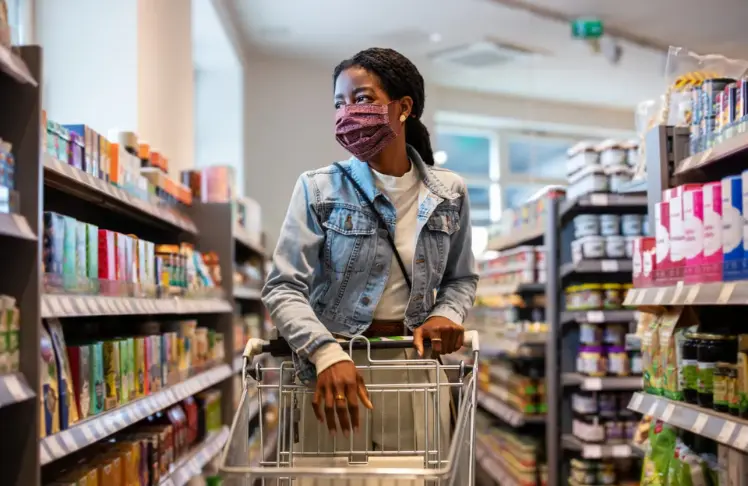
by Alexa Spencer
The Centers for Disease Control and Prevention (CDC) announced new COVID-19 recommendations on March 1. The list of guidelines includes an end to five-day at-home isolation periods for people who test positive for the virus.
The updated guidelines — called Respiratory Virus Guidance — offer a “unified approach” to addressing respiratory illnesses, rather than a COVID-19-specific guidance. All recommendations now apply to COVID-19, RSV, and the flu.
The question remains: Could the relaxed guidelines have a negative impact on frontline workers and communities of color? These groups are historically vulnerable to COVID-19 exposure and poor health outcomes if the virus is contracted.
“If we continue to make sure that we have the levels of vaccine coverage that we’ve had before, we will be in good standing,” says Dr. Reed Tuckson, the former commissioner of public health for the District of Columbia. Tuckson is a co-founder and board member of the Black Coalition Against COVID.

He says Black people and professionals were able to close major vaccine disparity gaps when the primary series was released. During that time, vaccines were administered at no-cost. Today, COVID-19 shots are available for free under insurance plans when the provider is in-network. For uninsured people, the federal government’s Bridge Access Program covers the cost, but the program is set to end on December 31.
Tuckson also says combining recommendations may be helpful.
“They decided to simplify things so that it just makes more sense for people to actually be able to implement the guidance. The context is that the flu season and the RSV season have now all become one with the COVID season,” he told Word In Black in a phone interview.
The CDC’s core respiratory illness prevention steps include:
- Staying up-to-date with vaccinations for COVID-19, RSV, and the flu.
- Covering coughs and sneezes, washing and sanitizing hands often, and cleaning frequently touched surfaces.
- Bringing in fresh outside air, purifying indoor air, and gathering outdoors.
Regarding isolation time, the Respiratory Virus Guidance recommends that people with symptoms of a virus isolate at home until they’re fever-free without the use of medicine for 24 hours. Similarly, they recommend one isolate until any other symptoms improve within the same time period.
Some people find it concerning that the CDC is ending the official five-day isolation period for COVID-19 and allowing people to leave home before all of their symptoms are completely cleared up. Tuckson says the CDC still wants infected people to isolate if they’re sick.
“You still want to be cautious. And I would recommend personally that if you’re still feeling unwell, don’t go to work, don’t be around others,” he says.
Mandy Cohen, director at the CDC, shared similar sentiments.
“We still must use the commonsense solutions we know work to protect ourselves and others from serious illness from respiratory viruses—this includes vaccination, treatment, and staying home when we get sick,” Cohen said in a statement.
But The People’s CDC, a “coalition of public health practitioners, scientists, healthcare workers, educators, advocates and people from all walks of life working to reduce the harmful impacts of COVID-19,” disagrees. In a March 4 op-ed published on Reckon, the group wrote that the CDC’s rollback of the 5-day isolation protocol ignores the dangers of long COVID, and “that intra-office transmission of COVID-19, a result of already insufficient workplace protections, leads to repeated episodes of short staffing levels.”
The coalition wrote that instead, “we need mandated universal paid sick leave and funding for long COVID-19 prevention and treatments, among other population interventions. We do not need more people spreading COVID-19 at work.”
According to the CDC, the updated guidelines are in response to a drop in hospitalizations and deaths associated with COVID-19. Compared to January 2022, weekly hospital admissions have decreased by more than 75% and deaths by more than 90%, the agency reported.
In the first week of 2024, 35,097 people were hospitalized, the CDC COVID-19 tracker shows. Limited federal data is available on the number of people who die from the virus-19. According to data collection by BNO News, 1,652 Americans died in the week between February 25 and March 3.
In addition to rates of poor health outcomes related to COVID-19, the CDC’s new guidance considered the cost of extended isolation, which included the fact that people with limited sick time may experience a financial loss.
“The bottom line is that when people follow these actionable recommendations to avoid getting sick, and to protect themselves and others if they do get sick, it will help limit the spread of respiratory viruses, and that will mean fewer people who experience severe illness,” Dr. Demetre Daskalakis, director at the National Center for Immunization and Respiratory Diseases, said in a statement.
The CDC also recommends that people get vaccinated and utilize testing. Shortly after the agency announced its new guidance, the White House announced an end to its free at-home COVID-19 test program. In the past, every household could order four tests by visiting COVIDtest.gov. As of Friday, March 8, that option will be suspended.















